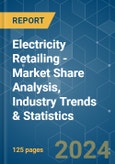The Electricity Retailing Market size is estimated at USD 547.04 billion in 2024, and is expected to reach USD 704.85 billion by 2029, growing at a CAGR of 5.20% during the forecast period (2024-2029).
This product will be delivered within 2 business days.
Key Highlights
- Over the medium period, the increase in the demand for electricity and the rising adoption of electric vehicles is expected to drive the market in the forecast period.
- On the other hand, new sources of distributed electricity generation are expected to restrain the market's growth.
- Nevertheless, advancements in the technology of the electricity retail market, like advanced meter and the requirement of power in the sub-Saharan Africa region, is expected to create opportunity for the market in the forecast period.
- Asia-Pacific is expected to dominate the market in the forecast period owing to the highest demand for electricity consumption in 2022.
Key Market Trends
Residential Segment is Expect to have a Significant Share in the Market
- Residential electricity use includes using electricity for lighting, heating, cooling, refrigeration, and operating appliances, computers, electronics, machinery, and public transportation systems.
- The United States has a significant share in World's electricity generation. In 2022, the country's share was 15.6% of the World's electricity generation.
- According to U.S. Energy Information Administration, total electricity consumption in the United States was about 4.05 trillion kWh in 2022, the highest amount recorded and 14 times greater than electricity use in 1950. Total electricity end-use consumption includes retail electricity sales to consumers and direct electricity use.
- Additionally, in 2022, the residential sector's retail electricity share was 38.9% of total electricity retail sales, 3.5% higher than in 2021. The total retail electricity consumption of the residential sector in the United States accounted for 1.42 trillion kWh in 2022.
- The adoption of smart meters, a significant measure of future-ready technologies, paves the way for the smart grid by enabling two-way real-time communication between distribution companies and consumers through general package radio services technologies. With supportive government policies for installing smart meters, the demand for retail electricity is expected to increase. In the residential sector, using smart meters can help improve the reliability and quality of electricity service for customers, track their electricity usage, and make informed decisions about reducing their energy consumption and saving money on their bills.
- For instance, in April 2022, European Union allocated around USD 134 million for five projects in the clean energy sector, including Advanced System for Remote Meter Reading Project. The project in Serbia will help the introduction of smart metering in the electricity distribution system in Serbia. The funds will be used for the first phase of smart meter deployment in Kraljevo, Cacak, and Nis.
- Thus, owing to the above points, the residential segment is expected to hold a significant market share.
Asia-Pacific is Expected to Dominate the Market
- Asia-Pacific is home to more than 50% of the global population and 60% of the large cities. The continent will face increasing demand for power in the future as millions of new customers are gaining access to electricity, with rapid population growth and industrialization.
- According to the Statistical Review of World Energy Data, in 2022, Asia-Pacific's total primary energy consumption accounted for 277.6 Exajoules, an annual growth rate of 2.1% compared to the previous year. A country like China has the highest electricity demand, accounting for 26.4 % of total world energy consumption.
- Various regional governments are also taking steps to apply modern technology in electricity retailing. Many countries in Asia-Pacific need more transmission and distribution (T&D) networks, and hence, electricity is not available in some of the remote and rural areas. To bring electricity to these areas, the countries in the region are investing heavily in building a transmission line network and smart metering system.
- For instance, in March 2023, the government of India implemented a nationwide Smart Meter program in the Revamped Distribution Sector Scheme (RDSS). Under this scheme, the government of India aims to install over 25 crore Smart Meters is envisaged across the country.
- Thus, owing to the above points, Asia-Pacific is expected to dominate the market in the forecast period.
Competitive Landscape
The global electricity retailing market is moderately fragmented. Some of the major companies (in no particular order) include Engie SA, AGL Energy Ltd., China Huadian Corporation LTD. (CHD), Duke Energy Corporation., and Electricite de France SA., among others.Additional Benefits:
- The market estimate (ME) sheet in Excel format
- 3 months of analyst support
This product will be delivered within 2 business days.
Table of Contents
1 INTRODUCTION
4 MARKET OVERVIEW
5 MARKET SEGMENTATION
6 COMPETITIVE LANDSCAPE
7 MARKET OPPORTUNITIES AND FUTURE TRENDS
Methodology

LOADING...










